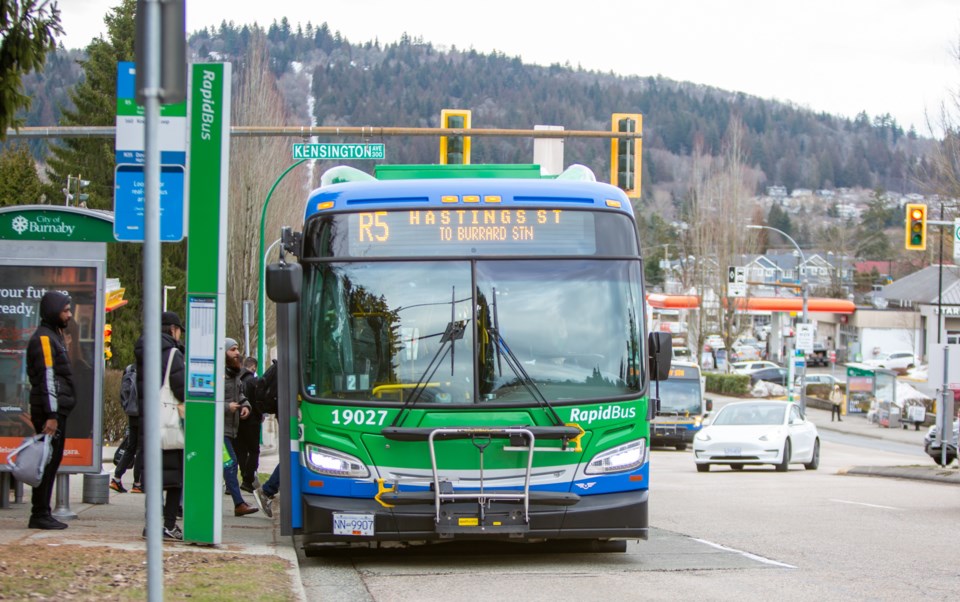If TransLink were looking for a transit rider to promote the RapidBus service in the region, Aeid Fouad might be their guy.
Standing at a bus stop near Hastings Street and Kensington Avenue in Burnaby Tuesday morning, Fouad had no complaints about the speed and reliability of the RapidBus he was about to board.
“The bus service is great here,” said Fouad, who was on his way to his sales job at Metrotown.
He takes the R5 Hastings Street bus to Willingdon Avenue, where he boards another bus that gets him to his destination. The trip is about 45 minutes, with delays minimal, he said, noting he takes the bus five days a week.
“It's not that much — five minutes some days, four minutes, three minutes, but a maximum of five minutes,” said Fouad, who pays $138 per month for his transit pass.
But had Fouad been taking the bus to a job in downtown Vancouver, his commuting experience might be less enjoyable, as was suggested in an updated TransLink study presented March 2 to the region’s mayors.
13 minutes longer
The Bus Speed and Reliability study revealed that during heavy traffic an end-to-end trip from Kensington Avenue to Burrard Station can take more than 13 minutes longer compared to a best-case trip, when the bus is able to move smoothly.
In fact, Hastings Street ranks first in bus delay per kilometre among 20 areas profiled in the study, which includes the chronically busy Broadway-to-University of B.C. corridor, which is expected to be alleviated when the Broadway subway opens in late 2025, or early 2026.
In the meantime, TransLink continues to work with municipalities to improve bus service, which is seeing delays grow in the suburbs, according to Stephen Newhouse, the lead planner for TransLink’s bus speed and reliability program.
“Delay remains concentrated in the Vancouver-UBC sub-region, but we have seen that the share of bus delay is growing fastest in the southeast and northeast sub-regions, followed by Maple Ridge-Pitt Meadows in the southwest sub-region,” Newhouse told the mayors from TransLink’s office in New Westminster.
“So this really is a regional challenge.”
Reallocating road space
The region’s growing traffic congestion is at the root of the delays.
That has triggered more calls for bus-only lanes, more buses and more frequent service to get riders to their destinations on time and without inconvenience, which is a challenging task and one that involves a fix that could make for some pushback from motorists.
“The most important thing that the leaders around this table can do is to communicate to staff that they have your support for implementing bus priority measures,” Newhouse said in response to a question from Jen McCutcheon, the director for Metro Vancouver’s Electoral Area A. “And that might include bringing difficult decisions to you about reallocating road space.”
Newhouse said 40 per cent of the delay that customers experience is concentrated on less than 10 per cent of the transit network. So, he added, that suggests strategic bus priority investments can address much of the delay experienced by customers.
Buses faster in early days of pandemic
During the pandemic, TransLink observed that bus ridership remained strong and rebounded faster than any other mode. Even today, at an 83 per cent recovery rate of people returning to transit, bus ridership is currently greater than pre-pandemic ridership of all other transit modes combined.
Newhouse said the early days of the pandemic and subsequent lockdown gave TransLink a unique opportunity to study the speed and reliability of the region’s bus service. Planners excluded the time buses spent at bus stops and focused on the time buses were in motion.
“We found that, overall, bus customers experienced 14 per cent faster speeds system-wide,” he said. “Some of the most well-travelled sections of the bus network were up to 25 per cent faster or better. So this gives us some indication of how much faster and more reliable buses could be if they were protected from congestion all the time.”
The financial cost of delays has grown with the congestion, with Newhouse saying annual operating costs since 2014 increased by $28 million to counteract the impacts of delay on buses.
Cumulatively, that growing delay has cost $155 million from 2014 to 2022, which Newhouse said was comparable to launching a new RapidBus route about every two years.
'It was really bad'
Metro Vancouver’s regional transportation strategy — Transport 2050 — aims to put transit within a short walk of most homes and jobs.
The goal is to be achieved by quadrupling the size of the rapid transit network from 100 to 400 kilometres and to rely heavily on buses.
For Fouad, meanwhile, the price of a car and operating it is keeping him on transit, even though a trip to work in a friend’s vehicle would take him 14 minutes — about a half hour less than his current bus journey.
But then he provided some perspective about his Burnaby commute in sharing a story about riding the bus one day from the Commercial Drive-Broadway transit hub to UBC.
“It was really bad,” he said. “It took me one hour and 20 minutes.”



